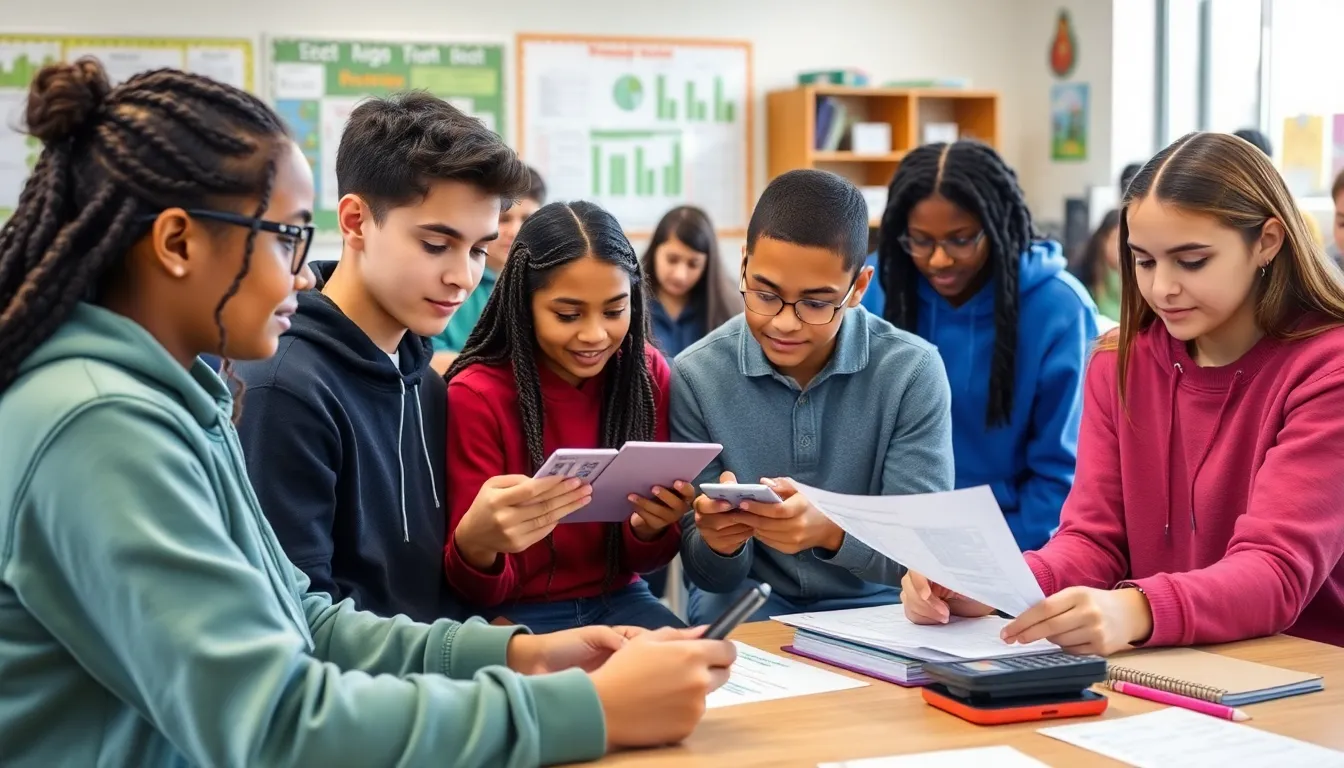In today’s fast-paced world, understanding finances is crucial for young adults. High school financial literacy equips students with essential skills to navigate their financial futures confidently. From budgeting to investing, these lessons empower them to make informed decisions that can shape their lives.
As students transition into adulthood, the lack of financial knowledge can lead to poor choices and long-term consequences. By integrating financial literacy into high school curricula, educators can help students grasp the importance of managing money wisely. This foundational knowledge not only prepares them for personal finance challenges but also fosters a generation of financially savvy individuals ready to thrive in an increasingly complex economic landscape.
Table of Contents
ToggleImportance of High School Financial Literacy
High school financial literacy plays a critical role in shaping informed, responsible adults. It equips students with fundamental skills for managing their finances effectively.
Benefits for Students
Students gain essential skills through high school financial literacy education. They learn to create budgets, track expenses, and develop saving habits. These skills enhance their understanding of credit scores, loans, and interest rates, enabling them to make informed decisions about borrowing and spending. Additionally, students become familiar with investment basics, including stocks and retirement accounts, fostering early financial planning. This knowledge promotes confidence in their financial capabilities, empowering them to navigate adult financial responsibilities successfully.
Long-Term Financial Health
High school financial literacy contributes to long-term financial health by instilling vital money management habits. Students who understand financial principles are less likely to incur high debt or face financial crises. Training in budgeting and saving sets them on a path toward sustainable spending and investment strategies. Ultimately, this early education helps reduce economic stress, leading to healthier lifestyles and better decision-making in the future. Financially literate individuals are more prepared to achieve personal financial goals, from homeownership to retirement planning, creating a stable and secure financial future.
Curriculum and Educational Approaches

High school financial literacy programs encompass diverse teaching strategies to engage students effectively. These approaches ensure that students gain practical financial skills relevant to their lives.
Traditional vs. Innovative Teaching Methods
Traditional teaching methods rely on lectures and textbook-based instruction. These methods provide foundational knowledge about financial concepts such as saving, investing, and budgeting. However, they may lack engagement, making it harder for students to relate to real-world applications.
Innovative teaching methods incorporate interactive elements, such as simulations and group projects. For example, students might participate in a budgeting simulation to manage a fictional income, fostering active participation. Gamification, where financial topics are presented through games, also enhances learning, as it encourages competition and collaboration. These innovative methods not only maintain students’ interest but also help them apply financial knowledge in practical situations.
Integration with Other Subjects
Integrating financial literacy into other subjects enriches students’ educational experiences. Subjects such as math, social studies, and economics provide ideal platforms for financial discussions. For example, students can apply math skills to calculate interest rates or analyze investment trends in economics.
Incorporating real-life projects, like business simulations, promotes practical application. Students learn about business expenses, revenues, and profitability alongside financial principles. This integration reinforces the relevance of financial literacy, helping students appreciate its significance across multiple disciplines.
Challenges in Implementing Financial Literacy Programs
Implementing financial literacy programs in high schools presents several challenges that can hinder their effectiveness. Understanding these obstacles is crucial for developing successful educational initiatives.
Resistance from Educators
Resistance from educators often arises due to perceived difficulties in integrating financial literacy into existing curricula. Many educators lack confidence in teaching financial concepts, especially if they don’t possess a strong financial background. Additionally, some educators feel overwhelmed by their current teaching responsibilities and view financial literacy as an added burden. This resistance can lead to inconsistent delivery of content and insufficient training for teachers, ultimately diminishing the quality of financial literacy education for students.
Lack of Resources
Lack of resources significantly impacts the effectiveness of financial literacy programs. Many schools face budget constraints that limit access to quality teaching materials and training. Availability of trained educators is often inadequate, leading to reliance on outdated or irrelevant content. Furthermore, schools situated in lower-income areas may struggle to provide even basic financial education due to minimal funding. This gap in resources prevents equitable access to essential financial literacy education, leaving some students ill-prepared for real-world financial challenges.
Case Studies and Success Stories
Several high schools across the United States have successfully integrated financial literacy programs, showcasing the positive impact on students’ financial knowledge and skills.
Effective Programs in Different States
- North Carolina: In North Carolina, the “Personal Finance” course, mandated for high school students, emphasizes budgeting, investing, and understanding credit. Schools report increased engagement and practical application of financial concepts among students.
- California: California’s “Jump$tart Coalition” promotes financial literacy through a comprehensive curriculum that combines classroom instruction with real-life simulations. Schools employing this program observe improved budgeting skills and more informed financial decision-making.
- Florida: Florida’s “Financial Literacy for Teens” initiative incorporates interactive workshops focusing on credit, loans, and savings. Feedback indicates heightened awareness and a significant increase in students’ willingness to save and invest.
- Texas: Texas mandates financial literacy education as part of its economics course. Schools see students expressing greater confidence in handling financial situations, such as applying for loans or managing expenses.
Impact on Student Performance
Research indicates that financial literacy education in high schools correlates with higher academic performance in relevant subjects and improved financial behaviors.
- Budgeting Skills: Students exposed to financial literacy develop budgeting skills, leading to more effective money management.
- Reduced Financial Stress: Programs help alleviate financial stress among students, enhancing overall academic performance by allowing them to focus on studies rather than financial concerns.
- Higher College Enrollment Rates: Evidence shows that financially literate students are more likely to pursue higher education, as they understand the costs and benefits associated with college.
- Improved Credit Understanding: A study reveals that students who participate in financial literacy programs achieve a better understanding of credit scores and loans, resulting in responsible borrowing practices and less reliance on credit cards.
These examples underscore the effectiveness of integrated financial literacy education in empowering students with necessary life skills.
High school financial literacy is crucial for preparing students to face the complexities of adult financial life. By equipping them with essential skills like budgeting and saving, educators can help foster a generation of informed decision-makers.
As students engage with innovative teaching methods and real-life applications, they gain confidence in their financial capabilities. Overcoming challenges in curriculum implementation is essential for ensuring that all students receive equitable access to this vital education.
Ultimately, investing in financial literacy programs not only benefits individual students but also contributes to a more financially responsible society. Empowered young adults are better equipped to navigate their financial futures and achieve their personal goals.




